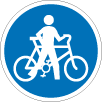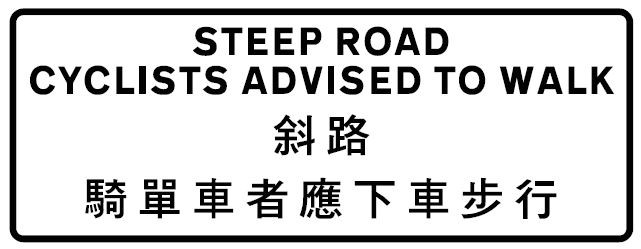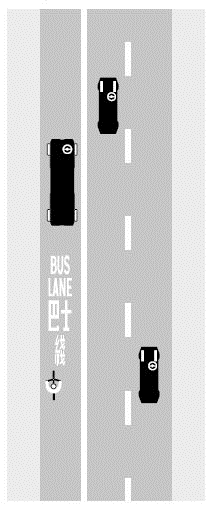
Regulatory sign - cycling restriction
Cycling is prohibited beyond the above sign. Cyclists must dismount and push their bicycles or tricycles to proceed beyond the sign until the end of the restriction.
Starting
Before you move off from the side of the road, think which way you intend to go and look ahead, behind and all around, particularly over your right shoulder, for moving traffic. If there is traffic approaching, wait until it has passed. When the traffic has passed, signal clearly with your right arm and then move off.
Stopping
Except in an emergency, stopping must be done carefully and gradually. Decide where you wish to stop and look particularly to the rear over your right shoulder for following traffic. Signal that you are going to slow down and stop. When braking, keep both hands on the handlebars.
On wet roads, it will take you more time and much longer distance to stop, so allow at least twice the normal distance.
Emergency stop
Do not signal. Keep both hands on the handlebars to maintain control and use both brakes. Move your bodyweight lower and back if you can.
Riding along
Always cycle within your ability. In particular, you should be comfortable with the road and traffic conditions. Safe riding requires skills not only in controlling the cycle, such as balancing, steering, starting and stopping, but also in the following key areas:
Always keep both hands on the handlebars unless you are signalling.
You must keep at least one hand on the handlebars at all times.
Always keep both feet on the pedals.
In general, keep to the left side of the road in single file and move at a steady speed. Look out for potholes, drains, road expansion joints, covers and track, etc.
When you are about to make a turn or come to a narrow road, you may ride in the middle of the lane if it is safe to do so and without causing serious disruption to traffic. Look out for following traffic when you move out. If you ride on a long narrow road, try to make a stop at a lay-by or some wider area to allow following vehicles to pass where possible.
You must not enter a tunnel area, a control area or an expressway. The start and end of such area are marked by traffic signs (see pages 71 and 73).
|
|
Regulatory sign - cycling restriction Cycling is prohibited beyond the above sign. Cyclists must dismount and push their bicycles or tricycles to proceed beyond the sign until the end of the restriction. |
|
|
Regulatory sign - End of cycling restriction |
 |
 |
|
| You must not ride or push your cycle past a traffic sign banning cycles. These are often found near elevated roads, flyovers and underpasses. | ||
You must not ride on pavement. If there is a cycleway or cycle lane along the road, you must use it. Do not stay on the cycleway if you need to stop or take a rest.
You must ride in single file except when overtaking or riding on cycleway.
You must not ride a cycle in the opposite direction to traffic on road.
Watch out for pedestrians, particularly young children, who may step or run onto the road suddenly.
Watch out for other vehicles, particularly when approaching a junction. Other drivers may turn left across your path.
Keep a safe distance from any vehicle you are following. Never get close to it. Otherwise, if it stops suddenly, you may not have time to do so.
You must never be towed or hold on to a vehicle or tow another cycle or other vehicle.
You must not carry any passenger. You must not carry any animal or anything which might obstruct your view, affect your balance or complete control of your cycle, or get caught in the wheels or chain.
Do not wear earphones of any audio devices or use mobile phone.
Do not lead any animal.
If riding at night or in poor visibility, you must switch on your cycle lamps to show a white light to the front and a red light to the rear. Ensure the lamps are on during your trip. Even in daylight, switching on your cycle lamps can help other road users see you. Adjust suitably your cycle lamp to dip downwards so as not to dazzle other road users.
Use of the bell
Use your bell to warn other road users, especially pedestrians, of your presence, but only when it is necessary.
Other motorists may not hear your warning bell, so you should take safety precautions as necessary.
You must not use your bell to demand other road users, especially pedestrians, to clear the way - unless in emergency such as you are unable to stop.
Steep cycleway
|
|
| Steep (downward) |
|
|
| Steep (upward) |
On steep sections of roads, take care of your speed - not to reach a speed from which you cannot stop safely. If you feel that you may not be able to control the cycle, you should dismount and push your cycle through that road section. The above signs indicate steep downward/upward cycleway sections ahead.

The sign above advises cyclists to dismount and walk down the steep road section ahead.
Overtaking
|
When riding along a road, you may need to overtake vehicles which are stopped or are moving more slowly than you, or to pass road works or stalls on the side of the road. Before overtaking a parked or slow-moving vehicle, think of which line you wish to take. Look behind over your right shoulder for approaching vehicles and let them pass before moving out. Time your manoeuvre so that you are not overtaking, as they pass you. Ensure also that while overtaking, you will be in no danger from vehicles coming in the opposite direction. Signal with your right arm before moving out. When you are about to overtake parked vehicles, you should look out for any pedestrians who may appear suddenly between the vehicles; also watch out for any driver or passenger of the stopped vehicle who are likely to open a door into your path. If possible, leave at least a door's width clearance between your cycle and the vehicle. |
It is very dangerous to overtake a vehicle on its left. You however may overtake/ pass on the left under the following situations only:
|
Do not pass between the kerb and a bus when the bus is at a stop. Wait until the bus moves off, unless it is safe to pass it on the other side and you can return to your normal path before the bus moves off.
You should never overtake on the left of or weave in and out of stationary or very slow moving traffic. It is often better to wait for the traffic to move.
Bus lanes
 You may use bus lanes unless there are signs banning cyclists. However, buses at bus lane may be travelling faster than the traffic in other lanes. Allow bus to pass when situation permits.
You may use bus lanes unless there are signs banning cyclists. However, buses at bus lane may be travelling faster than the traffic in other lanes. Allow bus to pass when situation permits.
Look out for pedestrians who may step unexpectedly onto the road and for drivers who may drive into a bus lane to gain access to premises or when taking evasive action. Be prepared to ride in normal traffic conditions at the end of the bus lane (for more information on bus lanes, see page 65).
Pedestrian crossings
You must give way to pedestrians on a 'Zebra' crossing. If there are pedestrians on the crossing, stop and wait behind the 'Give way' line. You must not weave through pedestrians on a crossing or try to force your way.
At 'Green man' crossings, you must stop and wait behind the 'Stop' line if the red light is showing. You may only go forward if the green light is showing and the way is clear. Give way to any pedestrians still on the crossing.